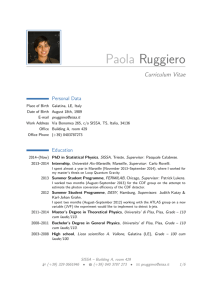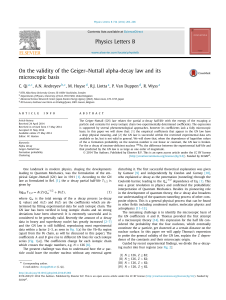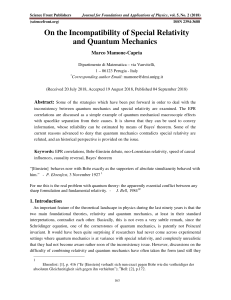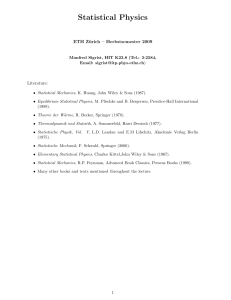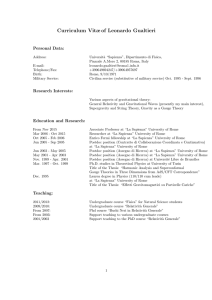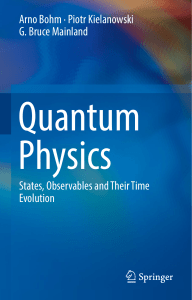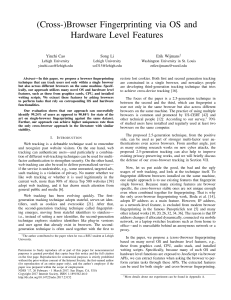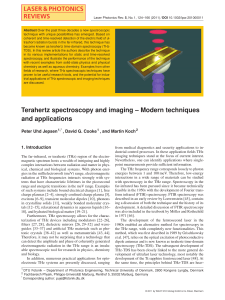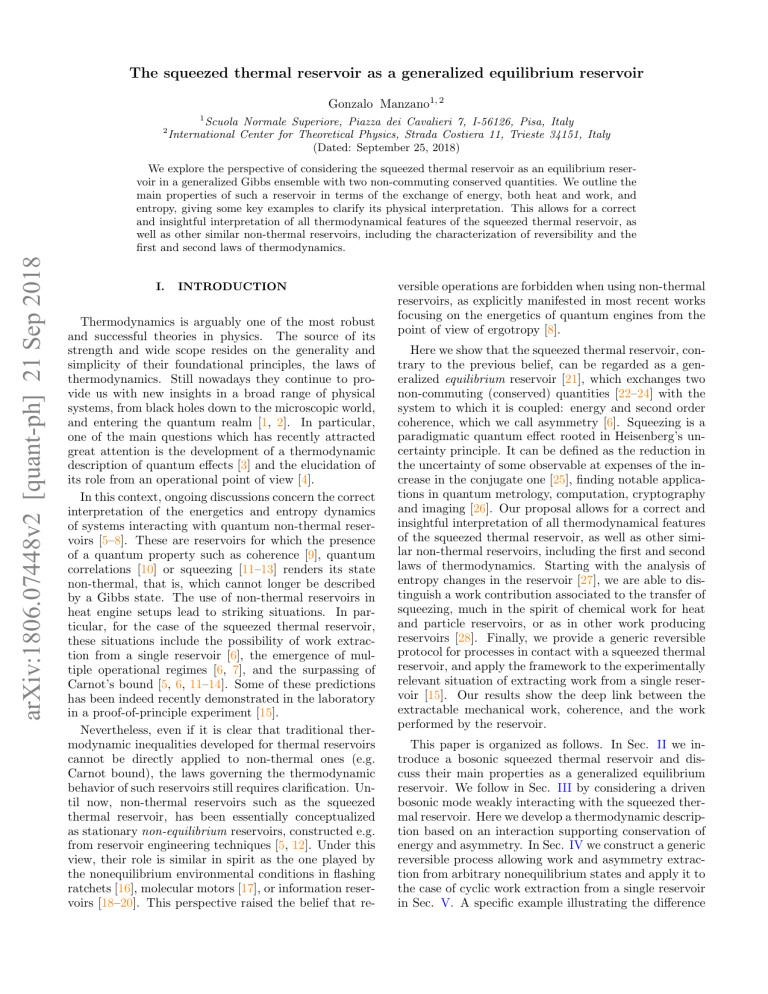
The squeezed thermal reservoir as a generalized equilibrium reservoir
Gonzalo Manzano1, 2
2
1
Scuola Normale Superiore, Piazza dei Cavalieri 7, I-56126, Pisa, Italy
International Center for Theoretical Physics, Strada Costiera 11, Trieste 34151, Italy
(Dated: September 25, 2018)
arXiv:1806.07448v2 [quant-ph] 21 Sep 2018
We explore the perspective of considering the squeezed thermal reservoir as an equilibrium reservoir in a generalized Gibbs ensemble with two non-commuting conserved quantities. We outline the
main properties of such a reservoir in terms of the exchange of energy, both heat and work, and
entropy, giving some key examples to clarify its physical interpretation. This allows for a correct
and insightful interpretation of all thermodynamical features of the squeezed thermal reservoir, as
well as other similar non-thermal reservoirs, including the characterization of reversibility and the
first and second laws of thermodynamics.
I.
INTRODUCTION
Thermodynamics is arguably one of the most robust
and successful theories in physics. The source of its
strength and wide scope resides on the generality and
simplicity of their foundational principles, the laws of
thermodynamics. Still nowadays they continue to provide us with new insights in a broad range of physical
systems, from black holes down to the microscopic world,
and entering the quantum realm [1, 2]. In particular,
one of the main questions which has recently attracted
great attention is the development of a thermodynamic
description of quantum effects [3] and the elucidation of
its role from an operational point of view [4].
In this context, ongoing discussions concern the correct
interpretation of the energetics and entropy dynamics
of systems interacting with quantum non-thermal reservoirs [5–8]. These are reservoirs for which the presence
of a quantum property such as coherence [9], quantum
correlations [10] or squeezing [11–13] renders its state
non-thermal, that is, which cannot longer be described
by a Gibbs state. The use of non-thermal reservoirs in
heat engine setups lead to striking situations. In particular, for the case of the squeezed thermal reservoir,
these situations include the possibility of work extraction from a single reservoir [6], the emergence of multiple operational regimes [6, 7], and the surpassing of
Carnot’s bound [5, 6, 11–14]. Some of these predictions
has been indeed recently demonstrated in the laboratory
in a proof-of-principle experiment [15].
Nevertheless, even if it is clear that traditional thermodynamic inequalities developed for thermal reservoirs
cannot be directly applied to non-thermal ones (e.g.
Carnot bound), the laws governing the thermodynamic
behavior of such reservoirs still requires clarification. Until now, non-thermal reservoirs such as the squeezed
thermal reservoir, has been essentially conceptualized
as stationary non-equilibrium reservoirs, constructed e.g.
from reservoir engineering techniques [5, 12]. Under this
view, their role is similar in spirit as the one played by
the nonequilibrium environmental conditions in flashing
ratchets [16], molecular motors [17], or information reservoirs [18–20]. This perspective raised the belief that re-
versible operations are forbidden when using non-thermal
reservoirs, as explicitly manifested in most recent works
focusing on the energetics of quantum engines from the
point of view of ergotropy [8].
Here we show that the squeezed thermal reservoir, contrary to the previous belief, can be regarded as a generalized equilibrium reservoir [21], which exchanges two
non-commuting (conserved) quantities [22–24] with the
system to which it is coupled: energy and second order
coherence, which we call asymmetry [6]. Squeezing is a
paradigmatic quantum effect rooted in Heisenberg’s uncertainty principle. It can be defined as the reduction in
the uncertainty of some observable at expenses of the increase in the conjugate one [25], finding notable applications in quantum metrology, computation, cryptography
and imaging [26]. Our proposal allows for a correct and
insightful interpretation of all thermodynamical features
of the squeezed thermal reservoir, as well as other similar non-thermal reservoirs, including the first and second
laws of thermodynamics. Starting with the analysis of
entropy changes in the reservoir [27], we are able to distinguish a work contribution associated to the transfer of
squeezing, much in the spirit of chemical work for heat
and particle reservoirs, or as in other work producing
reservoirs [28]. Finally, we provide a generic reversible
protocol for processes in contact with a squeezed thermal
reservoir, and apply the framework to the experimentally
relevant situation of extracting work from a single reservoir [15]. Our results show the deep link between the
extractable mechanical work, coherence, and the work
performed by the reservoir.
This paper is organized as follows. In Sec. II we introduce a bosonic squeezed thermal reservoir and discuss their main properties as a generalized equilibrium
reservoir. We follow in Sec. III by considering a driven
bosonic mode weakly interacting with the squeezed thermal reservoir. Here we develop a thermodynamic description based on an interaction supporting conservation of
energy and asymmetry. In Sec. IV we construct a generic
reversible process allowing work and asymmetry extraction from arbitrary nonequilibrium states and apply it to
the case of cyclic work extraction from a single reservoir
in Sec. V. A specific example illustrating the difference
2
between our approach and ergotropy-based approaches is
provided in Sec. VI. We conclude in Sec. VII with some
final remarks.
II.
THE SQUEEZED THERMAL RESERVOIR
Let us start by first defining the squeezed thermal
reservoir. We consider a set of N non-interacting bosonic
P
P
(k)
modes with Hamiltonian HR = k HR = k ~ωk b†k bk ,
with bosonic ladder operators [bk , b†l ] = δk,l . Assume
that each of them is in a squeezed thermal state, that is,
a canonical Gibbs state at some inverse temperature β0
to which the squeezing operator has been applied
(k)
(k)
ρR = S(ξ)
e−β0 HR †
S (ξ),
Zk0
(1)
(k)
where Zk0 = Tr[e−β0 HR ] is the partition function, S(ξ) =
exp[ 12 (b2k ξ ∗ − b†2
k ξ)] is the unitary squeezing operator and
iθ
ξ ≡ |ξ|e is the complex squeezing parameter. Along this
paper we will consider without loss of generality θ = 0.
Physically, the state in Eq. (1) corresponds to the output
of a parametric amplifier whose input is thermal noise
[25, 29].
Our main motivation is to interpret the above state
as a generalized Gibbs ensemble [21–24, 28, 30–33]. In
order to do this, we immediately notice that, since S(ξ) is
(k)
unitary, and whenever HR is quadratic, we can rewrite
(1) in a more convenient way:
(k)
(k)
ρR
(k)
e−β(HR −µAR )
=
.
Zk
(k)
(2)
(k)
with Zk = Tr[e−β(HR −µAR ) ]. Here we defined the following inverse temperature and a chemical-like potential
of squeezing:
β ≡ β0 cosh(2ξ), µ ≡ tanh(2ξ),
(3)
∆SR = S(ρ0R ) − S(ρR ) = −Tr[∆ρR ln ρR ],
together with the quantity
(k)
AR ≡ −
~ωk †2
bk + b2k ,
2
Ref. [34] for a different proof). Consequently, the inverse temperature β and the chemical-like potential of
squeezing defined in Eq. (3) are the conjugate variables
(k)
to the two (non-commuting) conserved quantities HR
(k)
and AR respectively, verifying maximization (Lagrange
multipliers).
(k)
A more physical picture of the observable AR in Eq.
(4), can be given by considering the case of (zero-mean)
Gaussian states. In such case it just corresponds to
the difference between the uncertainties in the mode
(k)
quadratures pk and xk , hAR iρ(k) = ~ω(∆p2k − ∆x2k ),
R
which is a measure of squeezing. For example, in the
case of the squeezed thermal state in Eq. (1) the uncertainties in the thermal (symmetric) state are multiplied by exponential factors depending on ξ, that is,
∆p2k = (2nkth + 1)e2ξ /2 and ∆x2k = (2nkth + 1)e−2ξ /2
[35] rendering the state asymmetric (squeezed) in phase
space. Here nkth = (eβ0 ~ωk + 1)−1 is the mean number
of excitations with energy ~ω in a thermal reservoir at
β0 . Consequently, state (1) shows a non-zero asymme(k)
try quantified by hAR iρ(k) = ~ω sinh(2ξ)(2nth + 1)/2.
R
Nevertheless notice that for more general states, the op(k)
erator AR takes into account both the the relative shape
of the uncertainties and the relative displacements in optical phase space [6].
In the following, we will show that this reservoir behaves in a very similar way to a particle reservoir at thermal equilibrium, but replacing the number of particles by
the asymmetry in Eq. (4), and consequently the traditional chemical potential by the chemical-like potential of
squeezing in Eq. (3). This can be done by noticing how
entropy behaves in the squeezed thermal reservoir. Let us
focus our discussion, without loose of generality, on a subset of modes in the reservoir. Consider an infinitesimal
change in the state of this subset ρ0R = ρR + ∆ρR , where
∆ρR is a traceless operator accounting for the changes,
and 1 is a real positive number. Then it follows that
up to first order in we have (see Appendix A and Ref.
[27]):
(4)
with energy units. We will refer to (4) as the secondorder moments asymmetry or just the asymmetry for
(k)
reservoir mode k, since it can be rewritten as AR =
2
2
(~ωk /2)(pk − xk ), where [xk , pl ] = i~δkl are the (dimensionless) position and momentum quadratures of the
modes [6]. Notice that Eq. (2) follows from the prop(k)
(k)
(k)
erty β0 S(ξ)HR S † (ξ) = β(HR − µAR ) + β0 sinh2 (ξ),
which is a direct consequence of the squeezing operator
action over ladder operators S(ξ)bk S † (ξ) = bk cosh(ξ) +
(k)
b†k sinh(ξ). We also notice that ρR is the state maximizing the von Neumann entropy of the reservoir mode k,
(k)
(k)
subjected to fixed averages hHR i and hAR i [21] (see
(5)
where S(ρ) = −Tr[ρ ln ρ] is the von Neumann entropy.
Introducing Eq. (2) into (5) we arrive to the central
relation:
∆SR = β (∆ER − µ∆AR ) ,
(6)
where ∆ER
=
Tr[HR ∆ρR ] and ∆AR
=
P (k)
Tr[ k AR ∆ρR ] are the corresponding changes in
energy and asymmetry of the reservoir.
As we will shortly see, Eq. (6) allows a physical interpretation of µ as the change in non-equilibrium free
energy needed to increase the asymmetry of the reservoir by a given amount. The nonequilibrium free energy
with respect to temperature T is defined as FR (ρR ) ≡
Tr[HR ρR ] − kB T S(ρR ) [36]. It characterizes the optimal amount of work extractable from a generic system
3
with Hamiltonian HR in state ρR with the help of a
thermal reservoir at temperature T [36–38]. Identifying
β = 1/kB T in Eq. (3) as the inverse temperature, and
using Eq. (6), we have that for any infinitesimal change
ρR → ρ0R , the change in nonequilibrium free energy is
∆FR = ∆ER − kB T ∆SR = µ∆AR . That is, the extractable work from this subset of modes, when access to
a thermal reservoir at β is possible, is directly proportional to the asymmetry of the subset AR . Remarkably,
this leads to interpret the quantity µ = ∆FR /∆AR , as
the work needed to increase the asymmetry by one unit.
Therefore WR ≡ µ∆AR is the analogous of a chemical
work, representing the work needed to increase the asymmetry of the reservoir.
Now combining Eq. (6) and the interpretation of µ,
we decompose the reservoir energy
∆ER = kB T ∆SR + WR ≡ QR + WR ,
(7)
where we interpret QR ≡ kB T ∆SR = ∆ER − µ∆AR as
the heat entering the squeezed thermal reservoir. This
approach is in contrast to the usual way of identifying
heat in quantum systems as the energy exchange between
system and reservoirs [1, 2]. While the later identification is correct when handling with thermal reservoirs,
the presence of further conserved quantities requires an
approach based on the reservoir entropy.
III.
THERMODYNAMICS AND ENTROPY
PRODUCTION
Until now we have just elucidated the properties of a
squeezed thermal reservoir made up by non-interacting
bosonic modes, and characterized by fixed parameters
β0 and ξ (or equivalently β and µ). Now we may move
to the description of the interaction between the reservoir and a system of interest. In particular, we consider
a driven system, typically another bosonic mode with
Hamiltonian HS (λ) = ~ωλ a†λ aλ , where ωλ and aλ may
be time-dependent through the external variation of a
control parameter λ(t). The system interacts with the
resonant modes of the reservoir through an interaction
Hamiltonian Hint (λ), which may also depend on λ.
In order to model the dynamical evolution we consider
a sequence of infinitesimal processes, each of which can
be divided in two basic steps. In the first step the system
weakly interacts with resonant modes in the reservoir following a global unitary
evolution Uλ = exp −iτ [HS (λ)+
HR + Hint (λ)]/~ . Here we assume that this interaction occurs in a time-scale τ much faster than the external driving, so that λ can be considered constant during
the system-reservoir interaction. In addition, we notice
that the much weaker interaction of the system with nonresonant modes in the reservoir can be neglected under
the present circumstances [6]. For any such first step in
the sequence of interactions, system and reservoir start in
a product state ρS ⊗ ρR with ρS the (generic) state of the
FIG. 1. (color online) Sketch of the sequence of processes
leading to the dynamical evolution in the main text.
system at that time, and ρR in Eq. (2). The states of system and reservoir after interaction read ρ0S = TrR [ρ0SR ]
and ρ0R = TrS [ρ0SR ], with ρ0SR = Uλ (ρS ⊗ ρR )Uλ† . After that, the second step in the dynamics is performed.
It consist in a smooth change of the control parameter,
λ → λ0 , producing some unitary
the sysR evolution in
tem alone, US = T+ exp − i dtHS [λ(t)]/~ with T+
the time-ordering operator. In this second step the system state change from ρ0S to ρ∗S = US ρ0S US† , while the
reservoir does not change at all. Finally, the reservoir
mode is replaced by a “fresh” mode in the same state
ρR , and the next interaction takes place [47]. In Fig. 1
we provide an schematic picture of the dynamical evolution. This kind of repeated interaction scheme can be
modeled by a sequence of completely positive and tracepreserving (CPTP) maps [39–42] leading to the development of Lindblad master equations [6, 39, 43] and quantum jump trajectories [46, 48], whose thermodynamic
properties can be addressed even for arbitrary environments [27].
The key assumption of the dynamical evolution will be
the presence of conserved quantities. The interaction between system and reservoir Hint should exactly preserve
both energy and asymmetry in the global system at any
time, that is [HS +HR , Hint ] = 0 and [AS +AR , Hint ] = 0.
Here the asymmetry in the systemAS is analogously
de
†2
2
fined as in Eq. (4) by AS (λ) ≡ aλ + aλ /2 for any
value of the external parameter λ. The later condition
for the commutators leads to the conservation of total
average energy and asymmetry for the first (interaction)
step of the evolution:
∆ES + ∆ER = 0,
∆AS + ∆AR = 0,
(8)
where ∆ES = Tr[HS (ρ0S − ρS )], ∆AS = Tr[AS (ρ0S − ρS )]
and analogously for the reservoir. It is worth noticing
that this assumption indeed prevents extra sources of
energy or asymmetry from switching on/off interactions
considered in [43, 49].
Moreover, during the second step of the dynamical evolution energy and asymmetry may change due to the action of the external driving. Then on a coarse-grained
time scale involving both first (interaction) and second
4
(driving) steps, we have
ĖS + ĖR = Ẇ ,
ȦS + ȦR = Ȧ
(9)
where Ẇ = Tr[ḢS ρS ] represents the mechanical work
performed by the external driver, and analogously Ȧ =
Tr[ȦS ρS ] is the asymmetry induced by driving. Now
combining Eqs. (7) and (9) we state the first law of
thermodynamics as
ĖS = Ẇ + Ẇsq + Q̇,
(10)
where Q̇ ≡ −Q̇R is the heat entering the system and
Ẇsq ≡ −ẆR = −µȦR is the chemical-like squeezing work
performed by the reservoir.
Conservation of energy and asymmetry in Eqs. (8) is
verified e.g. by prototypical beam splitter interactions
of the form Hint ∝ aλ b†k + a†λ bk , as the ones typically
assumed in derivations of the master equation for the
squeezed thermal reservoir [6, 44, 45]. For frozen λ, contact with the reservoir brings any initial state of the system in the long time run to the equilibrium state
ρeq
S (λ) = Sλ (ξ)
e−β0 HS †
e−β(HS −µAS )
Sλ (ξ) =
.
Z0
Zλ
(11)
Here Sλ (ξ) = exp[ 12 ξ(a2λ − a†2
λ )] is the squeezing operator over the system mode, and Zλ = Tr[e−β(HS −µAS ) ].
More generally, including the possibility of external driving into the system [Eq. (10)], the entropy production
rate of a generic process as described previously can be
calculated from the sum of von Neumann entropies of
system and reservoir [27]. That results in the following
statement of the second law
Ṡtot = Ṡ + ṠR = Ṡ + β(Ẇ + Ẇsq − ĖS )
= Ṡ + β(Ẇ − µȦ) − β(ĖS − µȦS ) ≥ 0,
(12)
where Ṡ (ṠR ) stands for the time-derivative of the von
Neumann entropy of the system (reservoir). For the
derivation of Eq. (12), we used the continuous version
of Eq. (6) for the reservoir entropy changes, together
with Eqs. (9) and (10).
IV.
by extending the protocol explained in Ref. [36] for standard thermal reservoirs (see also Ref. [50]) to the case of
a squeezed thermal reservoir.
This reversible process consists in two steps:
a) An initial sudden quench of the system Hamiltonian from HS (λ0 ) to HS (λ∗ ) ≡ H∗ , where
H∗ = ~ωλ∗ a†λ∗ aλ∗ ≡ −S † (ξ) ln(ρS )S(ξ)/β0 .
(13)
This step is implemented by an instantaneous
change in the control parameter λ0 → λ∗ , which
implies as well AS (λ0 ) → AS (λ∗ ) ≡ A∗ . The duration of this step is infinitesimal and, since the
change in the control parameter is instantaneous,
the system state does not change. Nevertheless,
this initial quench is crucial for implementing a reversible transformation, as long as it leaves the system in equilibrium with the squeezed thermal reservoir, ρS = exp[−β(H∗ − µA∗ )]/Z∗ , i.e. the state ρS
is now the equilibrium state of the system for H∗
and A∗ . Notice that for performing this quench a
work Wquench ≡ Tr[(Hλeq − HS )ρS ] and asymmetry Aquench ≡ Tr[(A∗ − AS )ρS ] are required, but no
entropy is produced.
b) A reversible isothermal-like transformation where a
quasi-static driving changes the Hamiltonian H(λ∗ )
and the asymmetry operator A(λ∗ ) back to their
initial forms, while the system interacts with the
reservoir. It is worth noticing that, since the
system starts this step in equilibrium with the
squeezed thermal reservoir, and the control parameter changes quasi-statically (infinitely slowly) from
λ∗ to λ0 , the system will be maintained in equilibrium with the reservoir at any time [Eq. (11)],
leaving the system in ρeq
S . This implies zero entropy production during the process (reversibility),
that is, Q̇ = kB T Ṡ . In Appendix B we indicate
a particular realization of this quasi-static process
using a concatenation of CPTP maps.
In order to obtain a quantitative link between the work
and asymmetry extractable from the initial state ρS , we
may integrate Eq. (12) for reversible conditions (equality case) along the two steps of the protocol. For this
purposes Eq. (12) can then be conveniently rewritten as
REVERSIBLE PROCESS
Our objective now is to construct a generic reversible
evolution for systems in contact with the squeezed thermal reservoir. We first consider the case of reversible
work and asymmetry extraction by transforming an arbitrary initial state ρS into the equilibrium state ρeq
S in
Eq. (11). The transformation ρS → ρeq
S might be done
by simply letting the system relax in contact with the
reservoir. However, this process is completely irreversible
and prevent us from extracting any mechanical work nor
asymmetry from ρS . On the contrary, a reversible protocol maximizing the extraction of resources can be built
β(Ẇ − µȦ) = −Żλ /Zλ .
(14)
Integrating Eq. (14) and identifying Wext = −Wquench −
R λ0
R λ0
eq
Tr[Ḣλ ρeq
λ ]dλ and Aext = −Aquench − λ∗ Tr[Ȧλ ρλ ]dλ
λ∗
as the total work and asymmetry extracted in the process, we obtain
Wext − µAext = Ω(ρS ) − Ω(ρeq
S )
= kB T D(ρS ||ρeq
S ) ≥ 0.
(15)
Here the quantity Ω(ρS ) ≡ Tr[(HS −µAS )ρS ]−kB T S(ρS )
is a potential generalizing the nonequilibrium free energy
5
for systems interacting with a squeezed thermal reservoir.
For obtaining (15) we used that Tr[(HS − µAS )ρeq
S ] −
kB T S(ρeq
S ) = −kB T ln Zλ . Moreover, in the last line we
introduced the relative entropy D(ρ||σ) = Tr[ρ(ln ρ −
ln σ)] ≥ 0, which reaches zero if and only if ρ = σ [51].
The interpretation of Eq. (15) may be now clarified by
introducing the squeezing work performed by the reservoir, Wsq = µ(∆AS + Aext ). We have:
Wext − Wsq + µ∆AS = kB T D(ρS ||ρeq
S ).
(16)
Eq. (16) tell us that any out-of-equilibrium state ρS 6=
ρeq
S is a resource which may be wasted in either extracting
a positive net amount of work, Wext − Wsq , or in increasing the asymmetry of the system, µ∆AS . Nevertheless,
notice that even when our initial state is in equilibrium,
ρS = ρeq
S , extraction of mechanical work is not forbidden
anymore, but it is allowed by cyclic extraction of asymmetry from the reservoir, Wext = Wsq = µAext .
The previous protocol may be applied to more general transformations ρS → ρ0S by including slight modifications. In such case step a) is applied exactly as before, but in the quasi-static step b) we replace the final value of the control parameter by some λ0∗ such that
H∗0 = H(λ0∗ ) ≡ −S † (ξ) ln(ρ0S )S(ξ)/β0 . This implies that
the system after quasi-static driving is now ρ0S . Then a
final step is included: c) A final sudden quench λ0∗ → λ
which instantaneously turns back the Hamiltonian and
asymmetry operator to their original forms, HS and AS .
This extension is indeed equivalent to the combination
of two reversible strokes, ρS → ρeq as before, followed by
the inversion of ρ0S → ρeq .
V.
CYCLIC WORK EXTRACTION FROM A
SINGLE RESERVOIR
Once reversible protocols have been introduced we may
now discuss work extraction from a single squeezed thermal reservoir. The idea is to introduce a thermodynamic
cycle on the system which combines unitary processes
on the system and interaction with the squeezed thermal
reservoir. In Ref. [6], we already introduced a thermodynamic cycle for work extraction: 1) Starting with the system in ρeq
S in Eq. (11), the system is first detached from
the reservoir and a unitary operation is implemented unsqueezing the mode U1 = S † . This leaves the system in
the state ρS = e−β0 HS /Z. 2) Then the squeezed thermal reservoir is reconnected and a simple relaxation take
places, bringing the state of the system back to ρeq
S . In
such protocol, work is extracted in the first unitary stroke
W1 , while the second stroke occurs in the absence of driving, and then the system only exchanges energy with the
reservoir. Notice that this second relaxation step is intrinsically irreversible (isochoric process) and therefore it
does not allow for an optimal use of the resources. Our
aim here is to replace the isochoric process by a reversible
process as introduced before.
Let us now generalize the previous two-stroke thermodynamic cycle for work extraction. 1) As before, the first
stroke consist in detaching the system from the reservoir
and implementing an arbitrary initial unitary step U1 ,
leaving the system in a rather arbitrary state ρS . During
this stroke an amount of work W1 = Tr[HS (ρeq
S − ρS )]
and asymmetry A1 = Tr[AS (ρeq
−
ρ
)]
are
extracted,
S
S
while the entropy production is zero. 2) Now, for the
second stroke we turn back to ρeq
S in contact with the environment, but also allowing arbitrary external driving.
This eventually leads to extracting some extra amount of
work W2 during this step, together with asymmetry A2 .
For this second stroke we may apply Eq. (12). Integrating it and using that by construction S(ρS ) = S(ρeq
S ),
∆ES = W1 , and ∆AS = A1 , a bound for the total work
extracted Wext = W1 + W2 is obtained
Wext ≤ µ(A1 + A2 ) = −µ∆AR = Wsq .
(17)
That is, in any cyclic process one may extract an amount
of work less or equal than the squeezing chemical-like
work performed by the reservoir. This indeed provides
an extra motivation to consider Wsq as work and the
squeezed thermal reservoir as a work producing reservoir
[28].
The key point for reaching the equality in Eq. (17)
is nothing but fully avoiding any irreversibility in the
second stroke of the cycle. This is accomplished when
this second stroke is exactly the (two-step) reversible process introduced below. Applying Eq. (15) it follows that
W2 = Ω(ρS )−Ω(ρeq
S )+µA2 = −W1 +µ(A1 +A2 ), and the
optimal amount of work Wext = W1 +W2 = µ(A1 +A2 ) =
Wsq is extracted. Furthermore, notice that this extraction protocol does not need any particular form of ρS
and U1 , e.g. we may use U1 = I [cf. Eq. (16)]. In any
case, the chemical-like squeezing work extracted from the
reservoir equals the asymmetry extracted by the external driver. Therefore, this can be regarded as an example
of a squeezing into work conversion in the context of a
generalized resource framework [22, 24].
VI.
ERGOTROPY AND WORK EXTRACTION
Finally, it is worth mentioning that the maximum extractable work from a single reservoir Wsq is larger in
general than the so-called ergotropy W of the non-passive
state ρeq
S induced by the squeezed thermal reservoir. The
later is defined as the maximum work extractable from
a state using only unitary operations describing a cyclic
variation of the Hamiltonian [52]. It can be straightforwardly seen that the ergotropy of the state ρeq
S is given
by W1 when U1 = S † [6]. We notice that this is just one
part of the total extractable work, Wsq = W1 +W2 , which
can be made arbitrarily larger when increasing ξ (see Fig.
2). In the following we provide explicit expressions for
W and Wsq .
†
−β0 HS
Since U1 = S † , leading to ρS = U1 ρeq
/Z,
S U1 = e
6
classical
initial sudden quench of the second stroke. Analogously,
= −A1 , so
for the extracted asymmetry we have Aquench
2
that until now we did not gained anything at all. Nevertheless, as we will shortly see, a greater amount of work
and asymmetry is going to be extracted in the quasistatic step of the stroke. This can be implemented by
means of the slow change of a control parameter λ from
λ∗ to λ0 , driving the Hamiltonian back to H0 . We will
parametrize this process as an unsqueezing of the Hamiltonian
quantum
HS (λ) = ~ωb†λ bλ ,
FIG. 2. (color online) Comparison of the optimal work reversibly extractable from a single squeezed thermal reservoir
Wsq (solid curve) with the protocol detailed in the text and
the ergotropy W (dashed curve). Both quantities are given
). In the inset we show their ratio,
in units of ~ω coth(β0 ~ω
2
which becomes more important when increasing the squeezing
parameter ξ. In both plots the black dashed vertical line indicates the boundary between classical and quantum regimes
for ~ω ∼ 10kB T0 , leading to ξ ∗ ∼ 1.5.
the work extracted in the first stroke explicitly reads:
W1 = Tr[H0 ρeq
S ] − Tr[H0 ρS ]
= ~ω sinh2 (ξ)(2nth + 1) ≡ W
(18)
where nth = (eβ0 ~ω − 1)−1 is the mean number of excitations with energy ~ω in a thermal reservoir at β0 .
Notice that ρS is the Gibbs state, and then it is the state
of lower energy for fix entropy. This implies that the
work W1 = W is by definition the ergotropy of state ρeq
S .
Moreover, during this stroke the asymmetry extracted
reads
A1 = Tr[A0 ρeq
S ] − Tr[A0 ρS ]
= Tr[A0 ρeq
S ] = ~ω sinh(2r)(nth + 1/2),
(19)
where A0 ≡ AS (λ0 ).
Next we calculate the work and asymmetry extracted
in the second (two-steps) reversible stroke of the cycle.
Following Eq. (13), in the first part of the stroke (sudden
quench) the Hamiltonian is modified from H0 to
H∗ ≡ ~ωb† b = S † (ξ)HS S(ξ),
(20)
where b = S † (ξ)aS(ξ), while the state of the system does
not change. At this point we can see that effectively after
the quench we have ρS = S(ξ)e−β0 H∗ S † (ξ)/Z0 , which is
the equilibrium state for Hamiltonian H∗ . In this step
the work extracted is
W2quench = Tr[ρS H0 ] − Tr[ρS H∗ ] = Tr[ρS H0 ]
− Tr[S(ξ)ρS S † (ξ)H0 ] = −W,
(21)
where we used Eq. (20). This means that the ergotropy
extracted in the first stroke is wasted in implementing the
bλ = S † (λ)aS(λ),
(22)
with λ∗ = ξ and λ0 = 0. These operations are usually
implemented in quantum optical setups like degenerate
parametric down conversion by passing the light from a
pumping laser field through a photonic crystal with χ(2)
nonlinearities (see e.g. [25, 55]). This kind of driving in
particular implies that
2
ḢS (λ) = ~ω(ḃ†λ bλ + b†λ bλ ) = −~ω λ̇(b†2
λ + bλ )
= 2λ̇AS (λ),
(23)
ȦS (λ) = ~ω(ḃλ bλ + b†λ b†λ ) = −~ω(2b†λ bλ + 1)
= λ̇(2HS (λ) + ~ω),
(24)
where we used ḃλ = −λ̇a†λ , following Eq. (20). In the
other hand, as shown in the previous section, the quasistatic driving implies the state of the system being at any
−β0 HS (λ) †
time ρeq
S (ξ)/Z0 . Therefore the work
S = S(ξ)e
extracted during the quasi-static stroke reads
Z 0
W2q−s = −
dλTr[AS (λ)ρeq
λ ]
ξ
= ~ω sinh(2ξ)(2nth + 1)ξ.
(25)
Analogously, for the extracted asymmetry we obtain
Z 0
A2q−s = −
dλTr[(2HS (λ) + ~ω)ρeq
λ ]
ξ
= ~ω cosh(2ξ)(2nth + 1)ξ.
(26)
In conclusion, during a single cycle we obtain a total
amount of extracted mechanical work and asymmetry
Wext = ~ωξ sinh(2ξ)(2nth + 1)
Aext = ~ωξ cosh(2ξ)(2nth + 1),
(27)
(28)
fulfilling Wext = µAext . Notice that the squeezing work
in the setup is strictly greater than the ergotropy for any
value of ξ, that is Wsq ≡ µAext > W, since ξ sinh(2ξ) >
sinh2 (ξ) ∀ξ > 0. This can be seen in Fig. 2 where
W and Wsq are plotted as a function of ξ, in units of
~ω coth(β0 ~ω/2).
Finally, we point that one way of looking at the quantumness of the squeezing effects is to look at the induced uncertainty in position or momenta quadratures
of our bosonic mode. In our case, for a squeezed thermal
7
state, the
√ squared uncertainty in the position quadrature
x = (1/ 2)(a + a† ) reads
Appendix A: Proof of Eq. (5)
e2ξ
,
(29)
2
and the Heisenberg uncertainty principle reads ∆x∆p ≤
1/2. A genuine quantum state is then reached when this
uncertainty falls below shot noise, i.e. when ∆2 x < 1/2.
This is equivalent to squeezing the quadrature over a certain quantity
1
ξ > ξ ∗ = ln(coth(β0 ~ω)).
(30)
2
The quantity ξ ∗ essentially depends on the relation between the magnitude of thermal fluctuations and the energy of the system. It diverges ξ ∗ → ∞ for high temperatures β0 → 0, while it approaches zero ξ ∗ → 0, when
the temperature goes to zero, β0 → ∞. For a relevant
parameter range β0 ~ω ' [0.01, 1] we obtain values of ξ ∗
from 2.65 to 0.39. As shown in Fig. 2, larger amounts
of work can be obtained in the quantum regime ξ > ξ ∗ ,
where the uncertainty in the squeezed quadrature falls
below shot noise.
In the following we provide a proof of Eq.(5) in the
main text, adapting the one given previously in Ref. [27].
Consider a change in the state of the reservoir
∆2 x ≡ hx2 i − hxi2 = (2nth + 1)
(k)0
ρR
(k)
(k)
= ρR + ∆ρR ,
(A1)
(k)0
where ρR is the state of the reservoir after some ar(k)
bitrary interaction with other system, ρR is the orig(k)
inal state, ∆ρR is a traceless operator accounting for
the change, and ≥ 0 is a positive (small) number. In
the following we will calculate the change in the von
Neumann entropy associated to this process, that is,
(k)0
(k)
∆SR = S(ρR ) − S(ρR ).
In order to proceed we need to calculate the eigen(k)0
values and eigenvectors of the state ρR , which we call
0
0
{λn , |λn i}. This can be done by using perturbation theory when 1. Indeed, up to second order in we will
have:
(2)
(1)
λ0n ' λn + λn + 2 λn ,
(2)
(1)
|λ0n i ' |λn i + |λn i + 2 |λn i ,
VII.
CONCLUSIONS
In this paper we explored the interpretation of the
squeezed thermal reservoir as a generalized equilibrium
reservoir with two non-commuting charges: energy and
(second-order moments) asymmetry. This identification
can be done provided that the interaction with the reservoir preserve the two quantities, a condition easy to be
fulfilled for the case of bosonic systems and in particular in the context of quantum optics (e.g. by a simple beam splitter interaction). Our formulation of the
first and second laws of thermodynamics solve the major
problem of how to correctly define work and heat for the
squeezed thermal reservoir, but the same approach also
applies to other non-thermal reservoirs such as the displaced thermal reservoir. In particular, our results show
how previous approaches based on the naive consideration of any energy exchanged with the reservoir as heat
[5, 6, 11, 12], or in the concept of ergotropy [7, 8] fail
to provide a complete explanation of the energetics and
thermodynamics. We expect that the identification of
the chemical-like squeezing work provided here together
with the generic reversible protocols may have a strong
impact in new designs of quantum thermal machines or
other devices combining thermal and squeezing effects.
where {λn , |λn i} are the eigenvalues and eigenvectors of
(k)
ρR , and we have also introduced the first and second
order contributions. In particular the first order ones
read
I would like to thank Juan M. R. Parrondo for encouraging me to do this work and Rosario Fazio for useful comments and discussions. I acknowledge financial
support from the Horizon 2020 EU collaborative project
QuProCS (Grant Agreement No. 641277).
(k)
(1)
λn = hλn | ∆ρR |λn i ,
(k)
P
hλ |∆ρR |λn i
(1)
|λn i = l6=n l λn −λ
|λl i .
l
(A3)
(A4)
Then we may write the change in entropy as
(k)0
(k)
∆SR = S(ρR ) − S(ρR )
X
X
=−
λ0n ln λ0n +
λm ln λm
n
(A5)
m
and using Eqs. (A2) we obtain up to second order in :
∆SR ' −
X
2
(2)
λ(1)
n ln λn − λn ln λn +
n
X 1 λ(1)2
m m
2 λm
.
If we now drop the second order term and use Eq. (A3)
we get
X
X
(k)
∆SR ' −
λ(1)
hλn | ∆ρR |λn i ln λn
n ln λn = −
n
=
ACKNOWLEDGMENTS
(A2)
(k)
−Tr[∆ρR
n
(k)
ln ρR ],
(A6)
which proofs Eq. (5) of the main text.
Appendix B: Reversible protocol with CPTP maps
Here we provide a particular realization of the protocol
for reversible transformations with a squeezed thermal
8
reservoir. It will be based on a concatenation of completely positive and trace preserving (CPTP) maps. As
explained in the main text, for a system bosonic mode
with Hamiltonian H and density operator ρ0 , the protocol consists in a first sudden quench, where the Hamiltonian changes as H → Heq ≡ −S ln ρ0 S † /β0 while leaving
the system in state ρ. Then this is followed by a quasistatic process where Heq transforms back to H. During this path the system remains in equilibrium with the
squeezed thermal reservoir at any time, ending thus in
ρeq = Se−β0 H S † /Z. Notice that here for the ease of
notation we drop the subscript S in all quantities.
In order to give a map describing the quasi-static process, we extend the one developed in Ref. [50], where an
isothermal processes for the case of a thermal reservoir
were constructed by alternating infinitesimal adiabatic
and isochoric steps (see also [54]). Let’s assume the following sequence of CPTP maps E1 ◦ E2 ◦ ... ◦ EN , with
N → ∞. Each map in the sequence is intended to describe an infinitesimal time step, for which En (ρn−1 ) =
ρn . The changes in the Hamiltonian in each step can be
also written as Hn−1 → Hn , and we set for consistency
HN ≡ H.
Now we decompose every CPTP map E in the sequence
in the following two steps
En (ρ) ≡ Gn ◦ Un (ρ).
(B1)
We introduced Un (ρn−1 ) = ρn−1 as a unitary sudden
quench of the system Hamiltonian, where Hn−1 → Hn
instantaneously. The second step is provided by a CPTP
−β0 Hn
−β0 Hn
map verifying Gn (S e Zn S † ) = S e Zn S † , that is, a
generalized Gibbs-preserving map, which describes the
interaction with the environment. During the action of
Gn the Hamiltonian is assumed to remain constant.
The key condition to ensure a reversible process is that
the change in the entropy of the system equals (minus)
the change in entropy of the reservoir, here given by the
last term in Eq. (13) of the main text:
∆Sn ≡ S(ρn ) − S(ρn−1 ) = βTr[(Hn − µAn )(ρn − ρn−1 )]
= β0 (Tr[SHn S † (ρn − ρn−1 )]) ≡ −βQn ,
(B2)
where An = [p2θ/2 − x2θ/2 ]/2 is the asymmetry. Here we
have only Hn (and An ) in the expression because the
entropy of the system only changes during the second
step, Gn (ρn−1 ) = ρn , when it interacts with the reservoir. This requires that the system state is close to the
instantaneous equilibrium state for every step, namely
−βHn
S e Zn S † . In order to warranty this, we show that when
assuming an infinitesimal change in the drive during any
step, that is
Hn = Hn−1 + ∆Hn
with 1, then the sequence of CPTP maps defined by
Eq. (B1) verify Eq. (B2) up to first order in .
In order to give a proof we proceed as follows. First,
we will show that if the state of the systems starts close
to ρeq
n−1 before the map, then, after the application of the
map En it remains close to the equilibrium state ρeq
n . We
can rewrite this condition as
−β0 Hn−1
e
†
ρn = Gn S
S + ∆ρn−1
Zn−1
=S
e−β0 Hn †
S + ∆ρn + O(2 ),
Zn
eβ0 ∆Hn = 1 + β0 Hn + O(2 ),
Zn−1 = Zn [1 + β0 Tr[∆Hn ] + O(2 )],
e−β0 Hn
∆Hn S † )
Zn
e−β0 Hn †
S ,
Zn
(B5)
which combined with linearity give us the following result
(B6)
then Eq. (B4) is recovered. The second part of the proof
now follows by obtaining the traceless matrix σn . Using
If we now make the identification
− β0 Tr[∆Hn ]S
(B4)
where ∆ρn−1 and ∆ρn are traceless operators accounting
for the deviations from the equilibrium states before and
after the map. If the above condition is verified, then
our construction is self-consistent. Then, as a second
step, we will proof that, since we may always rewrite
ρn = ρn−1 + σn for a suitable traceless σn (in general
∆ρn 6= σn ), this implies Eq. (B2).
We introduce Eq. (B3) into the left-hand-side of Eq.
(B4). Then we use the expansions
−β0 Hn−1
−β0 Hn e
e
1 + β0 ∆Hn + O(2 )
Gn S
S † + ∆ρn−1 = Gn S
S † + Gn (∆ρn−1 )
Zn−1
Zn
1 + β0 Tr[∆Hn ] + O(2 )
−β0 Hn
e
= Gn S
1 + β0 (∆Hn − Tr[∆Hn ]) + O(2 ) S † + Gn (∆ρn−1 )
Zn
−β0 Hn
e
e−β0 Hn
e−β0 Hn †
=S
S † + Gn (∆ρn−1 ) + β0 Gn (S
∆Hn S † ) − β0 Tr[∆Hn ]S
S + O(2 ),
Zn
Zn
Zn
∆ρn ≡ Gn (∆ρn−1 ) + β0 Gn (S
(B3)
(B7)
9
Eq. (B7) and the above expansions it reads:
σn ≡ ρn − ρn−1 = En (∆ρn−1 ) − ∆ρn−1
−β0 Hn
+ β0 En (S
e
Zn
∆Hn S † ) − S
e
−β0 Hn
Zn
in entropy during the n-th step of the process, described
by the map En . Using Eqs. (B9) and (B10), we obtain:
(B8)
∆Hn S † ,
∆Sn = S(ρn ) − S(ρn−1 )
X
X
=−
pkn ln pkn +
pkn−1 ln pkn−1
k
which, as expected is of order . Then, we may express
the eigenvalues and eigenvectors of ρn , the set {pkn , |ψnk i},
in terms of the corresponding ones for ρn−1 . This needs
to use the relation ρn = ρn−1 + σn , with σn in Eq. (B8).
We can always write
pkn
k
=
|ψn i =
pkn−1
k
k
+ hψn−1
|σn |ψn−1
i + O(2 ),
k
k
X hψn−1
|σn |ψn−1
i l
k
|ψn−1
i+
|ψn−1 i
k
l
pn−1 − pn−1
l6=k
k
Finally, by combining Eqs.(B9) and (B11), we notice that
pkn−1 =
k
e−β0 En
Zn
(B9)
+ O(). Therefore we have:
k
e−β0 En + ln[1 + O()]
Zn
k
e−β0 En = ln
+ O().
Zn
ln(pkn−1 ) = ln
+ O(2 ).
(B10)
On the other hand, we may obtain the same quantities
−β0 Hn
to first order in from the equation ρn = S e Zn S † +
∆ρn + O(2 ). This leads to:
k
X
k
k
= −
hψn−1
|σn |ψn−1
i ln pkn−1 + O(2 ). (B13)
(B14)
This leads us to write
k
X
e−β0 En
k
k
hψn−1
|σn |ψn−1
i ln(
) + O(2 )
Zn
k
X
k
k
= β0
Enk hψn−1
|σn |ψn−1
i
∆Sn = −
k
e−β0 En
+ hEnk |S † ∆ρn S|Enk i + O(2 ), (B11)
Zn
k
X hE k |S † ∆ρn S|E k i
k
n
n
k
l
2
= −Tr[SHn S † σn ] + O(2 ),
(B15)
|ψn i = S |En i + k
l S |En i + O( ),
e−β0 En
e−β0 En
k
k
−
l6=k
where,
in
the
last
step,
we
have
used
|p
i
=
|p
Zn
Zn
ni +
n−1
(B12)
O() = S |Enk i+O(), which follows from Eqs. (B10) and
(B12) and the cyclic property of the trace. Eq. (B15) corwhere {Enk , |Enk i} are the eigenstates and eigenvectors of
responds to Eq. (B2) up to first order in , and completes
the Hamiltonian Hn . We can now calculate the change
the proof.
pkn =
[1] J. Goold, M. Huber, A. Riera, L. del Rio, P. Skrzypczyk,
The role of quantum information in thermodynamics:
a topical review, J. Phys. A: Math. Theor. 49, 143001
(2016).
[2] S. Vinjanampathy, and J. Anders, Quantum Thermodynamics, Contemp. Phys. 57, 545-579 (2016).
[3] M. Lostaglio, D. Jennings, T. Rudolph, Quantum coherence, time-translation symmetry, and thermodynamics,
Phys. Rev. X 5, 021001 (2015); M. N. Bera, A. Riera, M.
Lewenstein, A. Winter, Generalized laws of thermodynamics in the presence of correlations, Nature Commun.
8, 2180 (2017).
[4] L. del Rio, J. Aberg, R. Renner, O. Dahlsten, and V. Vedral, The thermodynamic meaning of negative entropy,
Nature 474, 61-63 (2011); P. Skrzypczyk, A. J. Short,
and S. Popescu, Work extraction and thermodynamics for
individual quantum systems, Nature Commun. 5, 4185
(2014); M. Perarnau-Llobet, K. V. Hovhannisyan, M.
Huber, P. Skrzypczyk, N. Brunner, and A. Acı́n, Extractable work from correlations, Phys. Rev. X 5, 041011
(2015).
[5] O. Abah and E. Lutz, Efficiency of heat engines coupled
to nonequilibrium reservoirs, EPL 106, 20001 (2014).
[6] G. Manzano, F. Galve, R. Zambrini, and J. M. R. Par-
[7]
[8]
[9]
[10]
[11]
[12]
[13]
rondo, Entropy production and thermodynamic power of
the squeezed thermal reservoir, Phys. Rev. E 93, 052120
(2016).
W. Niedenzu, D. Gelbwaser-Klimovsky, A. G. Kofman,
and G. Kurizki, On the operation of machines powered
by quantum non-thermal baths, New. J. Phys. 18, 083012
(2016).
W. Niedenzu, V. Mukherjee, A. Ghosh, A. G. Kofman,
and G. Kurizki, Quantum engine efficiency bound beyond
the second law of thermodynamics, Nat. Commun. 9, 165
(2018).
M.O. Scully, M.S. Zubairy, G.S. Agarwal, and H.
Walther, Extracting work from a single heat bath via vanishing quantum coherence, Science 299, 862-864 (2003).
R. Dillenschneider and E. Lutz, Energetics of quantum
correlations, EPL 88, 5003 (2009).
X. L. Huang, T. Wang, and X. X. Yi, Effects of reservoir
squeezing on quantum systems and work extraction, Phys.
Rev. E 86, 051105 (2012).
J. Roßnagel, O. Abah, F. Schmidt-Kaler, K. Singer, and
E. Lutz, Nanoscale heat engine beyond the Carnot limit,
Phys. Rev. Lett. 112, 030602 (2014).
L. A. Correa, J. P. Palao, D. Alonso, and G. Adesso
Quantum-enhanced absorption refrigerators, Sci. Rep. 4,
10
3949 (2014).
[14] B. K. Agarwalla, J.-H. Jiang, and D. Segal, Quantum
efficiency bound for continuous heat engines coupled to
noncanonical reservoirs, Phys. Rev. B 96, 104304 (2017).
[15] J. Klaers, S. Faelt, A. Imamoglu, and E. Togan, Squeezed
thermal reservoirs as a resource for a nanomechanical
engine beyond the Carnot limit, Phys. Rev. X 7, 031044
(2017).
[16] J.M.R. Parrondo, B.J. de Cisneros, Energetics of Brownian motors: a review , App. Phys. A 75, 179-191 (2002).
[17] U. Seifert, Efficiency of autonomous soft nanomachines
at maximum power, Phys. Rev. Lett. 106, 020601 (2011).
[18] D. Mandal and C. Jarzynski, Work and information processing in a solvable model of Maxwell’s demon, Proc.
Natl. Acad. Sci. USA 109, 11641 (2012).
[19] S. Deffner, and C. Jarzynski, Information processing and
the second law of thermodynamics: An inclusive, Hamiltonian approach, Phys. Rev. X 3, 041003 (2013).
[20] A. C. Barato and U. Seifert, Stochastic thermodynamics with information reservoirs, Phys. Rev. E 90, 042150
(2014).
[21] E. T. Jaynes, Information theory and statistical mechanics, Phys. Rev. 106, 620 (1957); Information theory and
statistical mechanics II, Phys. Rev. 108, 171 (1957).
[22] Y. Gurnayova, S. Popescu, A. Short, R. Silva, and P.
Skrzypczyk, Thermodynamics of quantum systems with
multiple conserved quantities, Nat. Commun. 7, 12049
(2016).
[23] N. Y. Halpern, P. Faist, J. Oppenheim, and A. Winter,
Microcanonical and resource-theoretic derivations of the
thermal state of a quantum system with noncommuting
charges, Nat. Commun. 7, 12051 (2016).
[24] M. Lostaglio, D. Jennings, and T. Rudolph, Thermodynamic resource theories, non-commutativity and maximum entropy principles, New J. Phys. 19 043008 (2017).
[25] P. D. Drummond and Z. Ficek (Eds.), Quantum squeezing (Springer-Verlag, Berlin Heidelberg, 2004).
[26] E. S. Polzik, The squeeze goes on, Nature 453, 45-46
(2008).
[27] G. Manzano, J. M. Horowitz, and J. M. R. Parrondo,
Quantum fluctuation theorems for arbitrary environments: adiabatic and non-adiabatic entropy production,
Phys. Rev. X 8, 031037 (2018).
[28] J. M. Horowitz and M. Esposito, Work producing reservoirs: Stochastic thermodynamics with generalized Gibbs
ensembles, Phys. Rev. E 94, 020102(R) (2016).
[29] H. Fearn and M. J. Collett, Representations of squeezed
states with thermal noise, J. Mod. Opt. 35, 553 (1988).
[30] M. Rigol, V. Dunjko, V. Yurovsky, and M. Olshanii, Relaxation in a completely integrable many-body quantum
system: An ab initio study of the dynamics of the highly
excited states of 1D lattice hard-core bosons Phys. Rev.
Lett. 98, 050405 (2007).
[31] J.A. Vaccaro and S. M. Barnett, Information erasure
without an energy cost, Proc. R. Soc. A 467, 1770-1778
(2011); Beyond Landauer erasure, Entropy 15, 4956-4968
(2013).
[32] T. Langen, S. Erne, R. Geiger, B. Rauer, T. Schweigler,
M. Kuhnert, W. Rohringer, I. E. Mazets, T. Gasenzer,
and J. Schmiedmayer, Experimental observation of a generalized Gibbs ensemble, Science 348, 207-211 (2015).
[33] M. Perarnau-Llobet, A. Riera, R. Gallego, H. Wilming
and J. Eisert, Work and entropy production in generalised
Gibbs ensembles, New J. Phys. 18, 123035 (2016).
[34] Y.-K. Liu, Gibbs states and the consistency of local density matrices, arXiv:quant-ph/0603012 (2006).
[35] M. S. Kim, F. A. M. de Oliveira, and P. L. Knight, Properties of squeezed number states and squeezed thermal
states, Phys. Rev. A 40, 2494 (1989).
[36] J. M. R. Parrondo, J. M. Horowitz and T. Sagawa,
Thermodynamics of information, Nat. Phys. 11, 131-139
(2015).
[37] P. Skrzypczyk, A. J. Short and S. Popescu, Work extraction and thermodynamics for individual quantum systems, Nat. Commun. 4, 4185 (2013).
[38] R. Gallego, J. Eisert and H. Wilming, Thermodynamic
work from operational principles, New J. Phys. 18 103017
(2016).
[39] V. Scarani, M. Ziman, P. Stelmachovic, N. Gisin, and V.
Buzek, Thermalizing quantum machines: dissipation and
entanglement, Phys. Rev. Lett. 88, 097905 (2002).
[40] S. Lorenzo, R. McCloskey, F. Ciccarello, M. Paternostro,
and G. M. Palma, Landauers Principle in Multipartite
Open Quantum System Dynamics, Phys. Rev. Lett. 115,
120403 (2015).
[41] G. Manzano, J. M. Horowitz, and J. M. R. Parrondo,
Nonequilibirum potential and flucutation theorems for
quantum maps, Phys. Rev. E 92, 032129 (2015).
[42] F.Barra, and C. Lledó, Stochastic thermodynamics of
quantum maps with and without equilibrium, Phys. Rev.
E 96, 052114 (2017).
[43] P. Strasberg, G. Schaller, T. Brandes, M. Esposito,
Quantum and information thermodynamics: a unifying
framework based on repeated interactions, Phys. Rev. X
7, 021003 (2017).
[44] D. F. Walls and G. J. Milburn, Quantum Optics
(Springer, Berlin, 1994).
[45] M. O. Scully and M. S. Zubairy, Quantum Optics (Cambridge University Press, Cambridge, 1997).
[46] J. M. Horowitz, Quantum-trajectory approach to the
stochastic thermodynamics of a forced harmonic oscillator, Phys. Rev. E 85, 031110 (2012).
[47] Notice that since this “fresh” mode is freely provided by
the reservoir, the replacement does not incurs in any extra energetic cost. Moreover, since the state of the whole
reservoir changes only infinitesimally due to the interaction with the system, no extra entropy is produced [27].
[48] J. M. Horowitz and J. M. R. Parrondo, Entropy production along nonequilibrium quantum jump trajectories,
New J. Phys. 15, 085028 (2013).
[49] F. Barra, The thermodynamic cost of driving quantum
systems by their boundaries, Sci. Rep. 5, 14873 (2015).
[50] G. Manzano, F. Plastina, and R. Zambrini, Optimal
work extraction and thermodynamics of quantum measurements and correlations, Phys. Rev. Lett. 121, 120602
(2018).
[51] T. Sagawa, Second law-like inequalitites with quantum
relative entropy: An introduction, in Lectures on quantum computing, thermodynamics and statistical physics,
Kinki University Series on Quantum Computing, Vol. 8
(World Scientic, New Jersey, 2013).
[52] A. E. Allahverdyan, R. Balian, and Th. M. Nieuwenhuizen, Maximal work extraction from finite quantum
systems, EPL 67, (2004).
[53] H. T. Quan, Yu-xi Liu, C. P. Sun, and F. Nori, Quantum
thermodynamic cycles and quantum heat engines, Phys.
Rev. E 76, 031105 (2007).
[54] H. T. Quan, S. Yang, and C. P. Sun, Microscopic work
11
distribution of small systems in quantum isothermal processes and the minimal work principle, Phys. Rev. E 78,
021116 (2008).
[55] C. C. Gerry and P. L. Knight, Introductory Quantum
Optics (Cambridge University Press, 2005).


